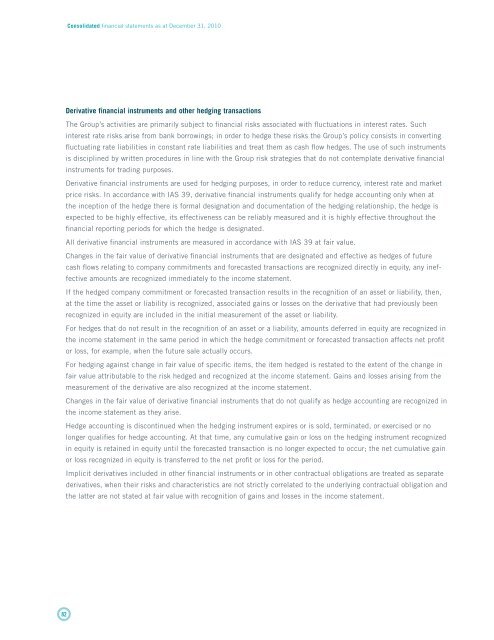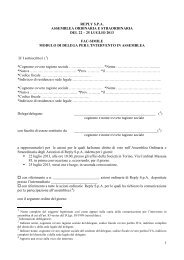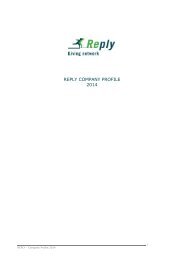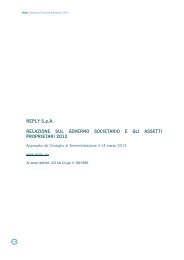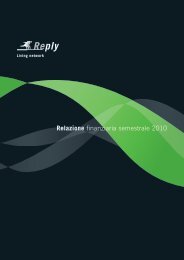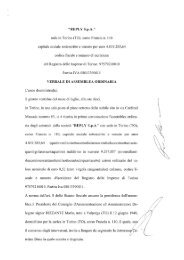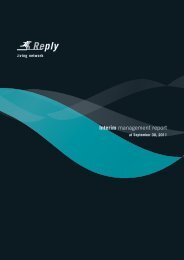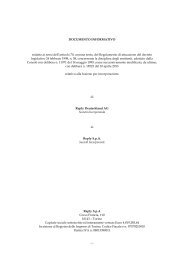Reply SpA
Reply SpA
Reply SpA
You also want an ePaper? Increase the reach of your titles
YUMPU automatically turns print PDFs into web optimized ePapers that Google loves.
Consolidated financial statements as at December 31, 2010<br />
Derivative financial instruments and other hedging transactions<br />
The Group’s activities are primarily subject to financial risks associated with fluctuations in interest rates. Such<br />
interest rate risks arise from bank borrowings; in order to hedge these risks the Group’s policy consists in converting<br />
fluctuating rate liabilities in constant rate liabilities and treat them as cash flow hedges. The use of such instruments<br />
is disciplined by written procedures in line with the Group risk strategies that do not contemplate derivative financial<br />
instruments for trading purposes.<br />
Derivative financial instruments are used for hedging purposes, in order to reduce currency, interest rate and market<br />
price risks. In accordance with IAS 39, derivative financial instruments qualify for hedge accounting only when at<br />
the inception of the hedge there is formal designation and documentation of the hedging relationship, the hedge is<br />
expected to be highly effective, its effectiveness can be reliably measured and it is highly effective throughout the<br />
financial reporting periods for which the hedge is designated.<br />
All derivative financial instruments are measured in accordance with IAS 39 at fair value.<br />
Changes in the fair value of derivative financial instruments that are designated and effective as hedges of future<br />
cash flows relating to company commitments and forecasted transactions are recognized directly in equity, any ineffective<br />
amounts are recognized immediately to the income statement.<br />
If the hedged company commitment or forecasted transaction results in the recognition of an asset or liability, then,<br />
at the time the asset or liability is recognized, associated gains or losses on the derivative that had previously been<br />
recognized in equity are included in the initial measurement of the asset or liability.<br />
For hedges that do not result in the recognition of an asset or a liability, amounts deferred in equity are recognized in<br />
the income statement in the same period in which the hedge commitment or forecasted transaction affects net profit<br />
or loss, for example, when the future sale actually occurs.<br />
For hedging against change in fair value of specific items, the item hedged is restated to the extent of the change in<br />
fair value attributable to the risk hedged and recognized at the income statement. Gains and losses arising from the<br />
measurement of the derivative are also recognized at the income statement.<br />
Changes in the fair value of derivative financial instruments that do not qualify as hedge accounting are recognized in<br />
the income statement as they arise.<br />
Hedge accounting is discontinued when the hedging instrument expires or is sold, terminated, or exercised or no<br />
longer qualifies for hedge accounting. At that time, any cumulative gain or loss on the hedging instrument recognized<br />
in equity is retained in equity until the forecasted transaction is no longer expected to occur; the net cumulative gain<br />
or loss recognized in equity is transferred to the net profit or loss for the period.<br />
Implicit derivatives included in other financial instruments or in other contractual obligations are treated as separate<br />
derivatives, when their risks and characteristics are not strictly correlated to the underlying contractual obligation and<br />
the latter are not stated at fair value with recognition of gains and losses in the income statement.<br />
82


